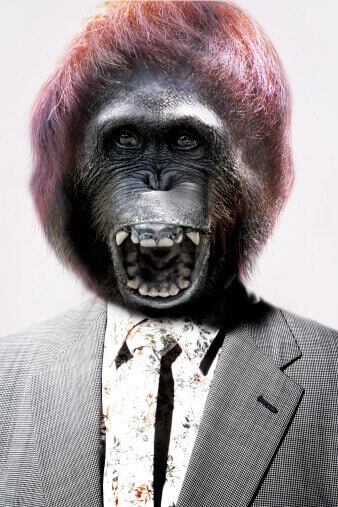Web design trends come and go. And then some die. They must die. We must say goodbye to them and move forward. Why? Because they have outlived their purpose and there is a new, better way to do things.
Web Design Trends That Didn’t Live Out the Year
Saying goodbye can be tough. Unless you are these web design trends, then it’s easy to send them on their way.
1. Skeumorphic Design
Skeumorpho-what? Skeumorphic design is the philosophy of making items on a website closely resemble what the items look like in the real world. Essentially, it means trying to create a 3-D effect on a 2-D or flat surface (like a computer screen) through the use of things like shadows, highlights and details.
Check out The Battle Between Flat Design and Skeumorphism to see a what skeumorphic design looks like.
Why did it die?
Although skeumorphic design intends to provide a great user experience by creating images that are easy to identify, it often ends up producing visual noise and clutter on the website. In addition to creating clutter, skeumorphic designs tend to be difficult to develop and are tougher to update in the future.
What’s next?
Flat User Interface Design is the current trend, especially for B2B web design. At the most basic level, it’s 2-D design for 2-D surfaces (sounds like a better match – doesn’t it?). The main bonus of Flat web design is that it is easily scalable for responsive design and reduces clutter to provide a seamless user experience.
2. Bad Stock Photography
 Just when you think it’s dead and gone, BAM! Terrible stock photography hits – which is one of
Just when you think it’s dead and gone, BAM! Terrible stock photography hits – which is one of
the main reasons to work with a qualified web designer and not your friend’s sister’s brother-in-law’s neighbor for a web design. But seriously, those terrible photos that you’ve seen on websites (hopefully not your own B2B website) are a thing of the past, much like laser disc players. Bad stock photography can be quite hilarious, but it never builds up credibility or trust with potential clients.
Why did it die?
In a word – competition. There is a lot more GOOD stock photography out there because the stock photography market is more competitive. New vendors and photography websites have come out to compete with the big vendors like iStock. With the option to have great stock photography, why bother with bad stock photography?
What’s next?
Stock photography isn’t dead, rather it’s alive and thriving because experienced photographers are now shooting with web design in mind. What makes up good stock photography? High-quality stock photography is not cheesy with unrealistic and unnatural poses. Instead, good stock photos have natural poses (if any poses at all), are artful and balanced, and include a ratio of negative space for web copy to seamlessly fit into.
3. Cluttered Websites
Bells, whistles, pop-ups, oh my! Which is better: a neatly organized closet with shoes in their places, a hanger for belts, and clothing organized by color or a tiny room where clothes, shoes, hats, purses and socks are bursting to escape? Unless you are a roach, the clear choice is the uncluttered closet.
Why did it die?
A cluttered website tries to convey too much info and too many messages at one time. You never know where to look or what to click on. A cluttered website is like a cluttered closet, you can never find what you are looking for and frustration sets in quickly. Too many messages communicated on a website means that none of the messages are communicated properly. Cluttered websites are done, gone, caput.
What’s next?
Minimalism is the path forward for many websites. A clean design with simplified messages creates a better user experience and strong brand identity. When it comes to B2B web design, less is really more.
4. Autoplay Ads, Videos, Media
Have you ever clicked on a search result to check out a website only to have obnoxious music start blaring – or worse – an ad start playing over the top of the website copy you are trying to read? Was it a race to close that tab and get away from that site as fast as possible? Autoplay Ads, Videos, Pop-ups and other Media can make for a frustrating, annoying, irritating, aggravating experience for the user.
Why did it die?
This actually hasn’t technically died, but it’s dead to most professional web design agencies. Why? Besides the fact that it’s annoying and distracts the user from their mission in visiting the site in the first place, it can increase bounce rates and create a sense of distrust with website users. Additionally, viewing metrics will be skewed as people quickly navigate away from the video or an ad that autoplays.
What’s next?
There is no question that multi-media must be incorporated into a B2B web design to provide a great user experience. However, how the user interacts with this media should be their choice. If they want to watch the video, they know to click on it to play. If the user would like to plug their headphones into their computer before watching your product video – let them do so, don’t force it.
5. Above the Fold Or Nothing!
Previous to 2015, there was a large emphasis on making sure all content was above the fold (where the computer screen stops). However, times have changed and users have adapted to technology. Trying to shove all the necessary content into a small space on a web design no longer has any benefit.
Why did it die?
Scrolling isn’t just some old form of note taking. Above the fold design still has relevance in things like landing page design, but for general B2B website design, above-the-fold-only design is dead. Users are familiar with swipe up, swipe down, scroll up, scroll down – largely due to mobile devices like tablets and smartphones.
What’s next?
Longer scrolling websites are becoming increasing popular, especially websites that integrate unique scrolling effects like parallax. The benefit of a website that allows scrolling to discover content is that it controls the brand story and messaging, directing users throughout the site based on the content they choose to interact with. It’s also a great way to establish the look and feel of the brand by taking the user on a closely controlled journey down the web page.
6. Desktop-Only Formats
A web design that is only formatted for desktop computers is dead. Gone. Later. Sure, a desktop often has a higher pixel resolution, larger memory for quicker loading times, and the ability to display on a large screen. But the harsh reality is that websites, even B2B websites, are accessed on a variety of devices. At the very minimum, an effective website strategy needs to include a mobile-friendly version of a company’s website or a responsive web design.
Why did it die?
Don’t forget that April of this year saw Google’s Mobilegeddon roll out. (How could we forget that scramble!) Google essentially laid down the gauntlet for web developers and designers, insisting that all websites be mobile-friendly or, better yet, responsive. While separate mobile sites are still a good option for existing websites – any new website design absolutely must be created as responsive.
What’s next?
Responsive web design that keeps multiple screen engagement in mind and considers how design will literally stack-up. For example, website designers create modules on a website, knowing that modules that appear side-by-side on a desktop will begin to stack on top of each other on a mobile device. Additionally, as mentioned before, scrolling is a functionality that must be considered in web designs that want to survive 2015 and beyond.
7. Design in a Silo
When it comes to creating a polished, engaging website design, it cannot be done in a silo. Web designers can no longer put on their headphones and focus only on the beauty of a website. A beautiful website might engender “ohhhs” and “ahhhs” but it likely won’t put new client leads on your desk (or email inbox).
Why did it die?
A website that is lovely, but doesn’t show up in search results is a wasted resource. Likewise, a website that has awesome images, but no clear call to action is throwing leads away. We aren’t saying web design can’t be gorgeous, but we are saying it must be so many other things as well to be effective.
What’s next?
Web design has turned a corner and now must include functionality along with engaging beauty. In addition to considering a company’s brand, a B2B web designer must consider content, the visual user experience, search engine optimization (SEO), conversions and the back-end development of the website. A web designer no longer pulls pretty pictures and lines them up; now a web designer must take a holistic view of the entire website strategy and user experience.
Why Did So Many Trends Die This Year?
Why did so many web design trends die this year? There has been a dramatic, industry-wide shift away from what a company wants to what the client (or consumer) wants. This is absolutely reflected in web design. Web design centers around the user’s needs and wants to create a great user experience that will turn a website visitor into a new client.



